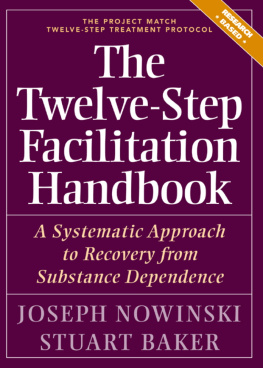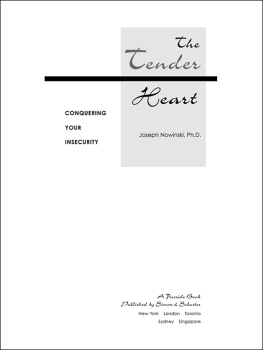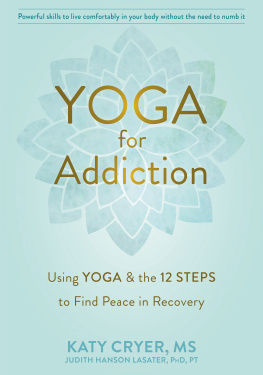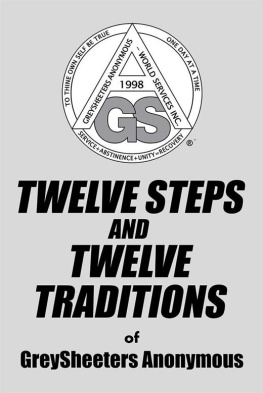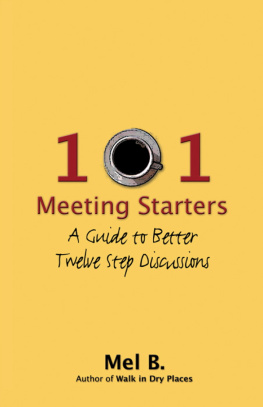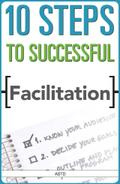The Twelve-Step
Facilitation Handbook
The Twelve-Step
Facilitation Handbook
A Systematic Approach to Recovery
from Substance Dependence
Joseph Nowinski
Stuart Baker

Hazelden Publishing
Center City, Minnesota 55012-0176
800-328-9000
hazelden.org/bookstore
1992, 2003 by Joseph Nowinski and Stuart Baker
Originally published by Lexington Books 1992. Originally titled The Twelve-Step Facilitation Handbook: A Systematic Approach to Early Recovery from Alcoholism and Addiction.
Published by Jossey-Bass, Inc., Publishers 1998
Published by Hazelden Foundation 2003with updated preface, new introduction, and updated references
Produced in the United States of America
No part of this electronic publication may be copied, sold, or redistributed in any form or by any means without the written permission of the publisher. Failure to comply with these terms may expose you to legal action and damages for copyright infringement.
ISBN: 1-59285-096-0
Ebook ISBN 978-1-61649-442-1
Cover design by David Spohn

About Hazelden Publishing
As part of the Hazelden Betty Ford Foundation, Hazelden Publishing offers both cutting-edge educational resources and inspirational books. Our print and digital works help guide individuals in treatment and recovery, and their loved ones. Professionals who work to prevent and treat addiction also turn to Hazelden Publishing for evidence-based curricula, digital content solutions, and videos for use in schools, treatment programs, correctional programs, and electronic health records systems. We also offer training for implementation of our curricula.
Through published and digital works, Hazelden Publishing extends the reach of healing and hope to individuals, families, and communities affected by addiction and related issues.
For more information about Hazelden publications,
Please call 800-328-9000
Or visit us online at hazelden.org/bookstore
for Maggie, Rebecca, and Gregory with love, from J. N.
and
For Mar-c, Aaron, and Maya:
Thank you for your inspiration and supportfrom S. B.
Preface
A lcoholics Anonymous (AA) is a program of hope and renewal that was born of despair and decay. Its birth came at a moment in history, marking a nexus of personal and historical forces. At that time, the ethic of radical individualism that had dominated American culture was straining under the weight of war and economic depression. It was a time when many ambitious and individualistic men, like Bill Wilson, had experienced failure as a result of personal excess and hubris, as well as larger forces beyond their control. It was a time ripe for quantum change of the sort that AA offered. Proof that AA was an idea whose time had come is the growth it has experienced since its initial struggles.
AA at its most elemental level can be thought of as a method for helping those who wish to drink no more to do so, one day at a time. It is a program of attraction that holds no prejudice against those who would deal with their drinking through some other means. AA wasand at heart still isa program for those who want it: for those men and women who believe that theyve tried everything else they want to try, and who now have a desire to stop drinking.
But AA and its sister twelve-step programs like Narcotics Anonymous (NA) offer nothing less than a program of personal transformation. Through its twelve steps and its twelve written (and many other oral) traditions, AA marks a pathway to profound changes in outlook, lifestyle, and spirituality for those who would pursue it. It provides guidelines for change on multiple levels, including behavior, thinking, values, relationships, and spirituality. Members of the fellowship, which is open to virtually anyone, are free to partake of as much or as little of the richness of the program as suits them.
From its inception in a few seminal groups of middle-class white male drunks in Ohio and New York, AA has grown into an international and multicultural fellowship of men and women, young and old. It has given rise to similar fellowships for drug addicts, overeaters, and others who suffer from compulsive self-destructive behaviors, and it has become a virtual culture unto itself. Evidence of this is that twelve-step fellowships possess their own coherent spiritual philosophy, backed up by a body of common wisdom that is readily accessible. They are guided by an elaborate system of ethics, rites, rituals, and traditions. Theyve developed their own language of a sort, and have proved capable of adapting themselves over time to widely disparate social and cultural conditions. Finally, through sponsorship, twelve-step fellowships have a means of passing down their values, wisdom, and traditions to newcomers. Each and every AA old timer is testimony to the vitality of the AA culture, as well as a carrier of that culture.
Is AA for everyone? To the extent that it is so pragmatic and flexible, the answer is probably yes. Were they to drop any preconceived ideas or prejudices they might hold toward AA, it is unlikely that anyone could not find something personally useful in it. On the other hand, as a treatment for alcoholism it remains to be seen if AA will stand the test of time, for surely it will continue to thrive only if its members find it useful. In terms of facts we know that approximately 40 percent of AA members who are sober and active in the program for less than a year will remain sober and active for a second year. Unless and until a more effective method is found, clinicians working with men and women who have symptoms of alcoholism or drug dependenceor who simply wish to stop drinking or using in their own interestmight do well to help facilitate their active involvement with AA and its sister twelve-step programs like NA.
The Twelve-Step Facilitation Handbook incorporates material originally developed for Project MATCH, a national collaborative study of alcoholism treatment funded by the National Institute on Alcohol Abuse and Alcoholism. The twelve-step facilitation manual developed for use in Project MATCH was also used in a study of treatment of concurrent alcohol and cocaine abuse sponsored by the National Institute on Drug Abuse. Both studies employed a patient-treatment matching design, intended to assess what kind of treatment works best with what kind of patient. When this book was originally published in 1992, Project MATCH had reported one-year post-treatment outcome results on 90 percent of its 1,726 subjects. The data showed that Twelve-Step Facilitation (TSF) was effective in significantly reducing drinking behavior and that this improvement was sustained at the time of the twelve-month follow-up assessment. Furthermore, TSF was found to be equally effective with moderate and severe problem drinkers. Overall, the Project MATCH results suggest that twelve-step oriented manual-guided intervention for alcohol abuse and alcoholism can be an effective treatment across a range of client demographics, personality variables, and problem severity.
We are grateful to the twelve-step facilitators who participated in these studies for the valuable feedback they provided. We would also like to acknowledge the support and encouragement of Kathleen Carroll in the process of developing the original twelve-step facilitation manual. In addition, we are grateful to Pat Owen, Dan Anderson, and Fred Holmquist of the Hazelden Foundation for their thoughtful feedback regarding our early work. Finally, we wish to thank the following people who reviewed and provided valuable comments on various drafts of the original twelve-step facilitation manual: William Miller, Tom Babor, Ronald Kadden, Bruce Rounsaville, Ellie Sturgis, Carlo DiClemente, Dave Barrett, Sandy Rasmussen, and Charlie Wilber.

